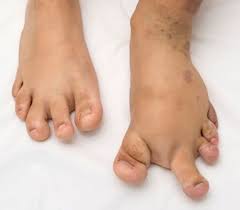
CLOVES syndrome is caused by mutations affecting PI3kinase.
It is a rare overgrowth syndrome with complex vascular anomalies.
The genetic disorder results from somatic, mosaic gain-of-function mutations of the PIK3CA gene, and belongs to the spectrum of PIK3CA-related overgrowth syndromes (PROS).
Somatic mutations in the PIK3CA have been identified as a cause of CLOVES syndrome.
PIK3CA is a protein involved in the PI3K-AKT signalling pathway.
Mutations in other parts of this pathway cause other overgrowth syndromes including Proteus syndrome and hemimegaencephaly.
Clinical effects range from mild fatty soft-tissue tumors to vascular malformations encompassing the spine or internal organs.
There are no specific treatments and it has a poor survival rate.
CLOVES syndrome is closely linked to other overgrowth disorders like proteus syndrome, Klippel–Trénaunay syndrome, Sturge–Weber syndrome, and hemihypertrophy and others.
CLOVES’ is an acronym for:
C is for congenital.
L is for lipomatous tumor made up of mature fat cells.
O is for overgrowth.
V is for vascular malformations, which are blood vessel abnormalies.
E is for Epidermal naevi.
S is for Spinal/Skeletal Anomalies or scoliosis.
CLOVES patients usually present with a soft fatty mass at birth, often visible on one or both sides of the back, legs and/or abdomen.
Overgrowth results in an abnormal increase in the size of the body or a body part that is often noted at birth.
Affected areas of the body grow faster than in other people.
Overgrowth of extremities is seen, with large wide hands or feet, large fingers or toes, wide space between fingers, and asymmetry of body parts.
Vascular malformations-CLOVES’ patients have different venous, capillary, and lymphatic channels.
Typically capillary, venous and lymphatic malformations are slow flow lesions.
However, some patients with CLOVES have combined lesions, slow and fast flow, and some have aggressive vascular malformations, arteriovenous malformations.
The symptoms of a vascular malformation vary, based on the type, size, and location of the malformation.
E is for Epidermal naevi-Sharply-circumscribed chronic lesions of the skin, and benign.
These are often flesh-colored, raised or warty.
S is for Spinal/Skeletal Anomalies or scoliosis-Some patients with CLOVES have tethered spinal cord, vascular malformations in or around their spines, and other spinal differences.
High-flow aggressive spinal lesions (like AVM) can cause serious neurological deficits/paralysis.
